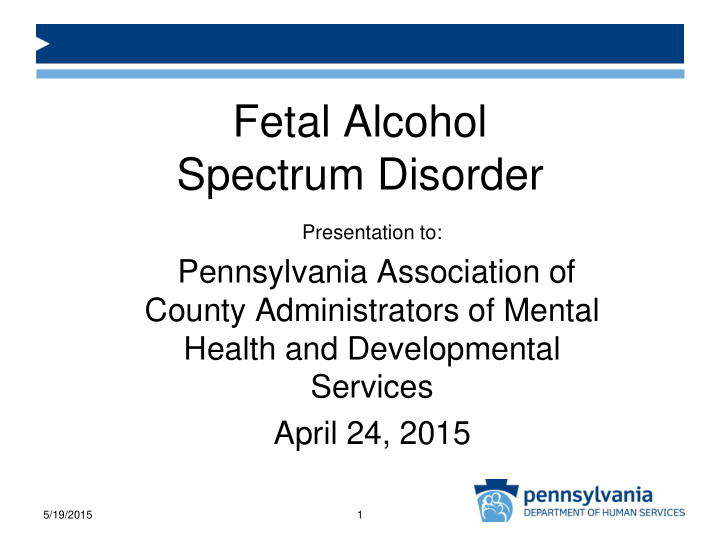



Fetal Alcohol Spectrum Disorder Presentation to: Pennsylvania Association of County Administrators of Mental Health and Developmental Services April 24, 2015 5/19/2015 1
Why Learn about FASD? • It is likely that every county has children (and adults) that could be identified as having FASD. • This includes children in the mental health, intellectual disability, juvenile justice, adoptive or foster care systems, as well as children in the general and the special education system. • Researchers have found that, for a child with identified FASD, incurred health costs were nine times higher than for children without an FASD . 4/24/2015 2
Definitions Fetal Alcohol Spectrum Disorder (FASD): • This is the umbrella term that describes the range of effects that may occur in an individual whose mother consumed alcohol during the pregnancy. • These effects may include behavioral, physical, mental, and learning disabilities with possible lifelong implications. 4/24/2015 3
FASD is in itself not a diagnostic term • The diagnostic terms that fall under FASD include the following: • Fetal Alcohol Syndrome (FAS)- “the leading known preventable cause of mental retardation and birth defects.” Sometimes identifiable through facial features. ( National Organization on Fetal Alcohol Syndrome, NOFAS ) • Partial Fetal Alcohol Syndrome (pFAS) • Alcohol Related Neuro-developmental Disorder (ARND), • Alcohol Related Birth Defects (ARBD) 4/24/2015 4
. Variation • Although prenatal alcohol exposure is cited as the leading preventable cause of intellectual disability, not all children exposed prenatally will have intellectual disabilities. • In a Canadian study the range of IQ of a person with FAS was between 20-120; the IQ of someone with ARND fell in the range of 42-142. • It is believed that about ten percent of those with an FASD will have an IQ under 70. • This generally means that 90 percent will have normal to higher than average IQ. 4/24/2015 5
But there are Behavioral Indicators: • Easily distracted, hyperactive, inattentive, impulsive • Consistently displays extreme behavior (aggression, emotional instability) • Has trouble remembering rules • Makes the same mistakes repeatedly • Low self-esteem 4/24/2015 6
Prevalence The generally cited combined prevalence of all FASDs, including FAS, Partial FAS, ARND, and ARBD – has been 1 percent of all births. But studies are starting to show much higher estimates! 4/24/2015 7
Emerging View of Prevalence • Paper published in Pediatrics in 2014 reported that using one method of prevalence estimation, they found that 2.86% had FASD. • Using a second method of prevalence estimation calculated from cases of FASD, they found an FASD rate of 8.2%. • A third study in an urban neighborhood identified 49% of the adults and youth had neurodevelopmental disorders with 39% having clinical profiles consistent with neurobehavioral disorders associated with prenatal alcohol exposure. 4/24/2015 8
Other Findings Child Welfare • Another 2014 paper, also in Pediatrics, found the rates of FASD in foster care and adopted youth were estimated to be higher than previously understood: • 28.5% of these youth had FASD, • 86.5% of these youth had never been diagnosed or were misdiagnosed, and • 26.4% of these youth were misdiagnosed as having ADHD. 4/24/2015 9
Growing Awareness • Initially, only heavy drinking was thought to be dangerous to the developing fetus, but over time there was increasing awareness of the risk posed by all alcohol consumption during pregnancy. • There has been a gradual progression, over more than 35 years, from denial that alcohol during pregnancy is dangerous to the fetus, to some level of recognition and concern, to a much greater level of concern, to current questioning of all previous assumptions about prevalence. 4/24/2015 10
Public Health Message • In 1981 in the United States, the Surgeon General’s “Advisory on Alcohol and Pregnancy” urged women for the first time to avoid all alcohol during pregnancy. • In 1997, it was definitively stated that “alcohol causes FAS” and that “drinking during pregnancy is linked with disaster” ( Streissguth & O’Malley, 1997 ). • But the message is not completely being heard. 4/24/2015 11
U. S. Department of Health and Human Services Ongoing problem • According to the U.S. Department of Health and Human Services, approximately 12 percent of pregnant women still drink alcohol, which means that one out of eight unborn babies are exposed to alcohol and are at risk for an FASD (2009). • SAMHSA website says: If you are pregnant, or may become pregnant, don't drink alcohol. • There is no known safe amount or type of alcohol to drink during pregnancy. 4/24/2015 12
Recommendations from OMHSAS Paper • Pennsylvania should increase awareness and knowledge related to FASD, including FASD prevention, identification, and intervention. • All child-serving systems should develop a coordinated FASD awareness and training plan. • Screening should be pursued in all child-serving systems. • Specialized assessment processes, including the use of neuropsychological testing when indicated, should be supported by public and private insurance companies. • Behavioral health providers should ensure that information about the possible use of alcohol and other substances during pregnancy are obtained and documented as part of the treatment protocol. 5/19/2015 13
OMHSAS and DDAP Collaboration with Department of Drugs and Alcohol Programs • Priority: Develop and implement a statewide plan to increase awareness regarding FASD; • The Department has reconvened the FASD Task Force to update the FASD State Plan for Pennsylvania; and • The Department will continue to require SCAs to provide two community activities related to FASD prevention during the state fiscal year. 4/24/2015 14
Growing Understanding about Intervention Suggestions for Counties: • The first priority will be prevention; • The next step would be screening to identify children, youth, and adults; • The third step is management and treatment – and we are rapidly learning that we need to consider something other than traditional mental health approaches, which have not been developed to address the permanency of FASD effects. 4/24/2015 15
Recommend
More recommend